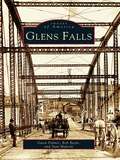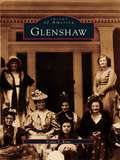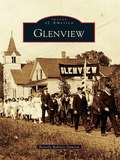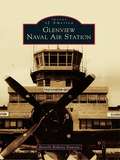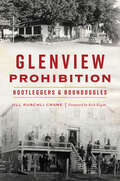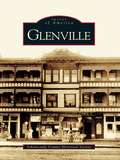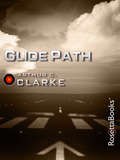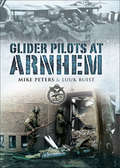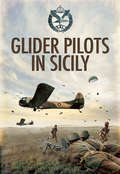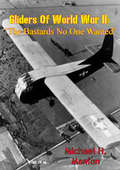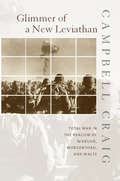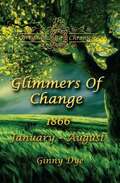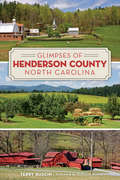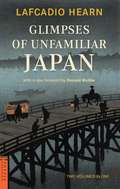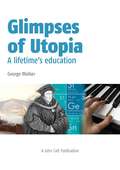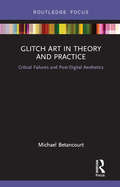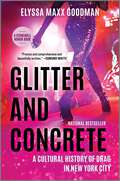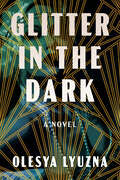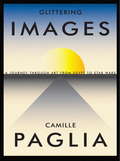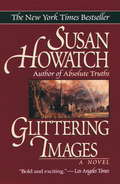- Table View
- List View
Glens Falls: People And Places (Images of America)
by Gwen Palmer Stan Malecki Bob BayleGlens Falls presents a photographic essay of a community on the Hudson River, midway between Saratoga Springs and Lake George. The book spans the years from 1860 to 1925, when Glens Falls was reaching its peak in economic, social, political, and cultural growth. Depicted in stunning images are the city's simple beginnings, the days of dirt roads traveled by horse and buggy, and its cultural emergence with opera houses, exquisite mansions, and public transportation. Clearly portrayed are the educational, religious, business, and recreational opportunities of the time.
Glenshaw (Images of America)
by Violet F. RoweCaptivating and entertaining, this new collection of historic images brings to life the past of Glenshaw, Pennsylvania, focusing on the period between the mid-1800s to the 1940s. With insightful captions and breathtaking images, readers are introduced to many of the early residents who shaped the future of this area of Shaler Township, and we are transported back in time to see early homes and places of work, play, worship, and education. In 1800, John Shaw Sr. purchased 600 acres of land just 8 miles north of the city of Pittsburgh. He built a log sawmill to prepare lumber for his home, and later built a log gristmill which stood until 1845 when his son replacedit with a larger mill. The new mill stood on property across from the local school, and the area became known as "Shaw's Glen. During the period covered in this book, Shaler Township, incorporated in 1837, grew from a quiet milltown of just 2,000 residents to a bustling suburb of the Steel City. Today, over 33,000 people call this area home.
Glenview
by Beverly Roberts DawsonFollowing the signing of the treaty of 1833, which required that local Potawatomi tribes relocate west of the Mississippi River, European settlers began to arrive in the area now called Glenview. Primarily of English and German origin, they established farms and trading posts. The Great Chicago Fire of 1871 had a profound effect on the hamlet. Lumber from the forests of Wisconsin used to rebuild the city was moved from the north via rail. By 1872, the Chicago, Milwaukee, St. Paul and Pacific Railroad laid the first set of tracks from Wisconsin to Chicago; the line brought prosperity to local residents. In 1899, the village was incorporated. The first mayor, Hugh Burnham, a nephew of Chicago architect Daniel Burnham, is credited with its name--Glen View. The community evolved into a mosaic of truck farms, major industry, small businesses, country clubs, polo fields, entrepreneurs, and colorful characters. Glenview maintained its ambiance as a "village of homes and gardens" until the latter years of the 20th century.
Glenview Naval Air Station (Images of America)
by Beverly Roberts DawsonIn 1923--just 20 years after the Wright brothers' first flight at Kitty Hawk--a Naval Reserve aviation training program was established at Great Lakes Naval Training Center. Originally, sea planes and a few small land-based planes were used for primary flight instruction. With the development of heavier, faster military aircraft, the Great Lakes facility became inadequate. Under Rear Adm. John Downes, commandant of the 9th Naval District, the search for a suitable new location was undertaken. Curtiss-Reynolds-Wright Airfield was deemed ideal for relocation of the aviation training program. From humble beginnings as Naval Reserve Aviation Base Chicago, Naval Air Station Glenview (the official U.S. Navy designation) went on to play a vital and unique role during World War II. Until closure in 1995, the base was home to thousands of Navy and Marine Reserve pilots, aircrews, and support personnel--proudly known as weekend warriors."
Glenview Prohibition: Bootleggers & Boondoggles
by Jill Ruschli CraneProhibition Glenview made many people rich, some angry, some sad, and some dead.Today, Glenview is one of the safest places to live in Illinois, but during Prohibition, speakeasies, saloons, and "ice cream parlors" hijacked the small farming town. Good men and women, trying make a few bucks, opened scores of taprooms and lounges along Waukegan Road. Beloved institutions like Hackney's restaurants, Meier's Tavern, and Grandpa's Place were originally supplied by a bootlegging operation that was both local and friendly. Then the Chicago Outfit moved in. Author Jill Crane traces the path the resilient citizens of Glenview took in carving a thriving community out of the tumult of Prohibition.
Glenville
by Schenectady County Historical SocietyGlenville recounts the rich and varied history of the town on the north side of the Mohawk River that crowns Schenectady County. Long before it became an incorporated town, Glenville was the site of the last great struggles between the Mohawk and Mohican Indians for control of the Mohawk Valley, the region's first European settlement (1661), and numerous raids and encampments during the colonial wars of the 18th century. From farming to factories and railroads to roadhouses, Glenville is a compelling look at the architecture, culture, industry, and economic forces integral to the lives of residents past, present, and future.
Glide Path: To The Heart Of Experimental Techologywwii (Arthur C. Clarke Collection)
by Arthur C. ClarkeA gripping novel of human ingenuity during World War II, based on the visionary author&’s own wartime experiences as a radar control operator. One of the most influential science fiction writers of the twentieth century, Arthur C. Clarke has consistently anticipated the actual achievements of science and technology. In Glide Path, he turns back the clock to tell a thrilling story about the groundbreaking exploration of radar during WWII. Clarke&’s only non–science fiction novel shines with the same qualities that made his award-winning space adventures timeless classics: topnotch suspense, fascinating science, and memorable characters. A hidden gem in Clarke&’s impressive body of work, Glide Path is an enthralling read for both science fiction fans and history aficionados.
Glider Pilots at Arnhem
by Mike Peters Luuk BuistThe fierce struggle between the British 1st Airborne Division and the superior German forces in and around Arnhem is well documented. This book tells of the role played in the battle for Oosterbeek and the bridge at Arnhem itself by the men of the Glider Pilot Regiment (GPR). These men were already experienced soldiers who volunteered to join the airborne forces and take the fight to the Germans in a totally new regiment.The men of the GPR were predominantly SNCOs trained to fly wooden assault gliders into occupied territory. Once on the ground they were expected to go into battle with the troops they had delivered onto the Landing Zone. During the Arnhem operation they were involved in the initial defense of the LZs, before fighting house to house leading mixed groups of infantrymen, engineers and medics. In so doing they suffered extensive losses from which the Regiment never fully recovered. This book tells their story in their own words from the moment they landed on Dutch soil through the fierce fighting all around the ever shrinking perimeter until the survivors of the GPR proudly marked the route out for the battered survivors of 1st Airborne Division as they escaped over the Rhine.
Glider Pilots in Sicily
by Mike PetersThe British Airborne landings on Sicily are the least known and, without doubt, the most fraught with political and technical strife. Newly formed Air landing troops were delivered into battle in gliders they knew little about. The men of the Glider Pilot Regiment (GPR) had self-assembled the gliders while living in the empty packing cases. They accomplished this complex and technically challenged task while living on fly ridden, dusty North African airfields. After only a few hours of conversion training they took off for a night flight across the Mediterranean Sea that was to end in near-catastrophe.With over three hundred soldiers drowned off Sicily that night in July 1943, the first major operation attempted by the British using gliders almost ended in total disaster. In fact a few Airborne troops reached dry land and attacked their objectives. Shining examples of collective and individual acts of courage rocked the Italian and German defenders. This book tells the controversial story of that first mass glider operation and the men who proved the GPR motto Nothing is Impossible.This is the first account of the Sicily air landing operation.
Gliders of World War II: ‘The Bastards No One Wanted’
by Major Michael H. ManionThis study examines the role of combat gliders in Germany, the United Kingdom, and the United States during World War II (WWII). This thesis compares and contrasts each country with respect to pre-WWII glider experience, glider and airborne doctrine, glider pilot training, and glider production while outlining each country's major glider operations. The author then compares the glider operations in the China-Burma-India Theater to the operations in Europe to describe the unique challenges based on the terrain and mission. Next, this thesis presents an analysis of the glider's precipitous decline following WWII. The study concludes with recommendations for glider operations in the future based on the experiences of the past.
Glimmer of a New Leviathan: Total War in the Realism of Niebuhr, Morgenthau, and Waltz
by Campbell CraigThe Second World War put an end to America's historical isolationism. Three American thinkers--Reinhold Niebuhr, Hans Morgenthau, and Kenneth Waltz--developed a modern strategic framework that sought to introduce Americans to the harsher realities of international politics. Yet even as the United States began to embrace this new Realism, atomic weaponry threatened to make it absurd. This engrossing story of how the three chief architects of a powerful ideology struggled with the implications of their own creation offers crucial context for contemporary debates about the resort to war and weapons of mass destruction.
Glimmer of a New Leviathan: Total War in the Realism of Niebuhr, Morgenthau, and Waltz
by Campbell CraigThe Second World War put an end to America's historical isolation from international power politics, and so also to the long-standing American defiance of the Realist ideology that shaped Old World affairs. The advent of transoceanic military technologies, now wielded by menacing states such as Nazi Germany and the Soviet Union, made Americans more receptive to the Realist idea that international relations is about fear and survival. The American Realists Reinhold Niebuhr, Hans Morgenthau, and Kenneth Waltz developed a modern strategic framework that sought to introduce American leaders and the educated public to these harsher realities of international politics. They emphasized a clear-eyed, cold approach to the play of interests, egotism, and the drive for power in world affairs—a struggle in which the threat of major war remained, in the end, the only legitimate currency. Yet even as Americans began to accept this new Realism, thermonuclear weaponry threatened to make it absurd. A major war to defend the nation might result in its total destruction; a thermonuclear war leading to the death of hundreds of millions of citizens seemed an unusual way to preserve American survival. This dilemma became central to the Realist understanding of Niebuhr, Morgenthau, and Waltz. How could a Realist approach to international politics and war be sustained in the face of possible global annihilation? Glimmer of a New Leviathan is the engrossing story of how the three chief architects of an influential ideology struggled with the implications of their own creation. It offers crucial historical context for contemporary debates about weapons of mass destruction and the post-Cold War international order.
Glimmers of Change (The Bregdan Chronicles Ser. #7)
by Ginny DyeGlimmers of Change continues the sweeping historical saga that encompasses the first full year of the American Reconstruction. However, has the Civil War really ended? As far as the characters are concerned, Carrie and Janie are living their dream in Philadelphia, but what price will they pay when cholera sweeps through America once again? Robert searches for peace on the plantation, but forces are in place that are determined to deny it. Moses and Rose are driven by forces beyond their control to become leaders in the midst of a violent racial revolution. Jeremy discovers love, but will the reality of his heritage make it impossible, and will he survive the forces determined to destroy the factory? Finally, will Matthew free his heart and find love?
Glimpses of Henderson County, North Carolina (American Chronicles)
by Terry RuscinHenderson County is known for its country inns, houses of worship and picturesque landscapes. Behind all the beautiful scenery is a colorful history that runs deeper than any creek or holler. Revel in the family and farming heritage of Edneyville, Clear Creek, Green River Township, Hoopers Creek and Fruitland. Relive the resort era when the region boomed as a tourist destination. Learn how the wee population center of Goodluck came by its name, and inhale the sweet fragrance of apple blossoms that bloom every springtime. Drawing from interviews, documents and a gallery of both contemporary and time-honored photography, author and researcher Terry Ruscin renders his adopted Henderson County in vivid detail.
Glimpses of Modern India-1 First Semester FYBA New NEP Syllabus - SPPU
by Miss Rupali KulkarniThe book Glimpses of Modern India-1 offers a comprehensive exploration of India's history during British rule, focusing on the socio-economic, political, and cultural transformations that shaped modern India. It begins with the establishment and expansion of British power, analyzing key events like the Battle of Plassey and the Sepoy Mutiny, which marked the onset of colonial dominance. The book highlights socio-religious reform movements such as the Brahmo Samaj and Arya Samaj, which sought to address societal inequalities and revitalize Indian traditions. It also traces the growth of Indian nationalism, the emergence of the Indian National Congress, and the revolutionary movements that galvanized the fight for independence. Designed as a textbook for undergraduate students, it aligns with the NEP 2024 syllabus, combining historical narratives with critical insights. With its structured content, engaging discussions, and exercises, the book serves as a valuable resource for both academic studies and competitive examinations.
Glimpses of Unfamiliar Japan
by Lafcadio Hearn Donald RichieAs an interpreter of Japan to the West, Lafcadio Hearn was without parallel in his time. His numerous books about that country were read with a fascination that was a tribute to his keen powers of observation and the vividness of his descriptions. Today, even though Japan has changed greatly from what it was when he wrote about it, his writing is still valid, for it captures the essence of the country-an essence that has actually changed a good deal less than outward appearances might suggest. In a word, the Japanese character and the Japanese tradition are still fundamentally the same as Hearn found them to be, and for this reason his books are still extremely revealing to readers in the West.Glimpses of Unfamiliar Japan combines the two volumes of a work that first appeared in 1894. Its title is apt, for the book takes the reader into a world that few Westerners saw in the late nineteenth and early twentieth centuries. Here are the customs, the superstitions, the charming scenery, the revelations of Japanese character, and all the other elements that Hearn found so bewitching. Here, for example, are essays on such subjects as the Japanese garden, the household shrine, the festivals, and the bewildering Japanese smile-all aspects of Japanese life that have endured in spite of the changes that have taken place during the modernization of Japan.In his preface to the book, Hearn writes: "This is the life of which a foreign observer can never weary, if fortunate and sympathetic enough to enter into it...Each day, while the years pass, there will be revealed to him, some strange and unexpected beauty in it." It is fortunate indeed that he was able to bring to his readers so much of this "strange and unsuspected beauty."
Glimpses of Utopia: A lifetime's education
by George WalkerGeorge Walker was director general of the International Baccalaureate and visiting professor in the University of Bath. In this collection of autobiographical essays he describes some defining moments in his distinguished career in education. In schools, of course, but also in the harvest fields of Essex and the Paleolithic cave at Lascaux; behind the Iron Curtain in Czechoslovakia; on the alpine ski slopes; in the concert hall and in the footsteps of Cecil Rhodes in southern Africa; in Baghdad and in Bosnia, there have been many unexpected lessons to learn.
Glimpses of Utopia: A lifetime's education
by George WalkerGeorge Walker was director general of the International Baccalaureate and visiting professor in the University of Bath. In this collection of autobiographical essays he describes some defining moments in his distinguished career in education. In schools, of course, but also in the harvest fields of Essex and the Paleolithic cave at Lascaux; behind the Iron Curtain in Czechoslovakia; on the alpine ski slopes; in the concert hall and in the footsteps of Cecil Rhodes in southern Africa; in Baghdad and in Bosnia, there have been many unexpected lessons to learn.
Glimpses of World History Part-1: உலக சரித்திரம முதல் பாகம
by Jawaharlal Nehruஜவாகிர்லால் நேருவின் 'உலக வரலாறுகளின் கருத்துக்கள்' புத்தகம், இந்தியாவின் முதல் பிரதம மந்திரி, இந்திரா காந்திக்கு உடைந்த பிரிசன் என்றும் அழைக்கப்படும், இந்தியத்தின் சுதந்திரசேனாகவும் அரசியலாகவும் பெருகின ஒ.வி. அழகேசன் அவரால் தமிழில் மொழிபெயர்க்கப்பட்டுள்ளது. இது, புகழப்படுத்தப்பட்ட உலக வரலாறுகளின் முக்கிய நிலைகளை உருவாக்குகின்ற புத்தகமாகும். முன்னிலையாக ஜவாகிர்லால், தன் மகளுக்கு எழுதிய 196 கடிதங்களின் தொகுப்பாக இருக்கும் இந்த புத்தகம், உலக வரலாற்றின் பெருக்கைகளை ஒருங்கிணைந்து காட்டுகிறது. இந்த மொழிபெயர்ப்பின் மூலம், அழகேசன் வழியாக நேருவின் உரிமைகளை தமிழ் மொழியில் உருவாக்கி, படிப்பாக்குகளுக்கு அணுகல் செய்து, புத்தகம் விரும்புபவர்களிடம் இனிதே புகழ் சேர்க்கின்றது. உலக வரலாறுகளை அணுகலாக அறிந்து கொண்டு, அனுபவிக்கலாம் என்பதை உடைந்துள்ள இந்த புத்தகம், தமிழ் மொழியில் மிகவும் அழகாக பரிந்துரைக்கப்பட்டுள்ளது.
Glitch Art in Theory and Practice: Critical Failures and Post-Digital Aesthetics
by Michael BetancourtGlitch Art in Theory and Practice: Critical Failures and Post-Digital Aesthetics explores the concept of "glitch" alongside contemporary digital political economy to develop a general theory of critical media using glitch as a case study and model, focusing specifically on examples of digital art and aesthetics. While prior literature on glitch practice in visual arts has been divided between historical discussions and social-political analyses, this work provides a rigorous, contemporary theoretical foundation and framework.
Glitter Everywhere!: Where it Came From, Where It's Found & Where It's Going
by Chris BartonFans of How It&’s Made will love this fresh, irreverent look at the science and story behind glitter.If you love glitter, this book is for you. If you hate glitter, this book is also for you.Everyone seems to have an opinion about glitter. But how much do you know about the tiny, shiny confetti? What makes glitter glitter? Why does it stick to everything? Who invented it? How is it made? Is glitter bad for the environment?Chris Barton&’s informative wit and Chaaya Prabhat's vibrant art make Glitter Everywhere sparkle as it covers the good, the bad, and shiny of all things glitter.
Glitter and Concrete: A Cultural History of Drag in New York City
by Elyssa Maxx Goodman*NATIONAL BESTSELLER**A STONEWALL AWARD HONOR BOOK**The Millions Most Anticipated List of 2023**A Vogue Best LGBTQ+ Book of 2023*From journalist and drag historian Elyssa Maxx Goodman, an intimate, evocative history of drag in New York City exploring its dynamic role, from the Jazz Age to Drag Race, in queer liberation and urban lifeFrom the lush feather boas that adorned early female impersonators to the sequined lip syncs of barroom queens to the drag kings that have us laughing in stitches, drag has played a vital role in the creative life of New York City. But the evolution of drag in the city—as an art form, a community and a mode of liberation—has never before been fully chronicled.Now, for the first time, Elyssa Goodman unearths the dramatic, provocative untold story of drag in New York City in all its glistening glory. Glitter and Concrete ducks beneath the velvet ropes of Harlem Renaissance balls, examines drag&’s crucial role in the Stonewall Uprising, traces drag's influence on disco and punk rock as well as its unifying power during the AIDS crisis and 9/11, and culminates with the modern-day drag queen in the era of RuPaul&’s Drag Race.Including original interviews with high-profile performers, as well as glamorous color photos from exclusive sources and the author herself, Glitter and Concrete is a significant contribution to queer history and an essential read for anyone curious about the story that echoes beneath the heels."Deeply researched and featuring a cast of characters who can truly be described as fabulous, Glitter and Concrete is urban history on fire." —Thomas Dyja, author of New York, New York, New York
Glitter in the Dark
by Olesya LyuznaThe search for a kidnapped singer in Prohibition-era New York leads an intrepid reporter from Harlem speakeasies to the dazzling world of the theater, all while grappling with her warring passions. Ambitious advice columnist Ginny Dugan knows she’s capable of more than solving other people’s beauty problems, but her boss at Photoplay magazine thinks she's only fit for fluff pieces. When she witnesses the kidnapping of a famous singer at Harlem’s hottest speakeasy, nobody takes her seriously, but Ginny knows what she saw—and what she saw haunts her. Guilt-ridden over her failure to stop the kidnappers and hard-pressed for cash to finally move out of her uptight showgirl sister’s apartment, Ginny resolves to chase down the truth that will clear her conscience and maybe win her a promotion in the process. When private detective Jack Crawford starts interfering with her case, Ginny ropes him into a reluctant partnership but soon finds herself drawn to the kind heart she glimpses beneath his brooding exterior. Equally as alluring is Gloria Gardner, the star dancer of the Ziegfeld Follies who treats life like one unending party. Yet as Ginny delves deeper into the criminal underworld, the sinister plot she uncovers seems to lead right back to the theater. Then a brutal murder strikes someone close to her, and Ginny realizes the stakes are higher than she ever imagined. This glamorous world has a deadly edge, and Ginny must shatter her every illusion to catch the shadowy killer before they strike again.
Glittering Images
by Camille PagliaFrom the best-selling author of Sexual Personae and Break, Blow, Burn and one of our most acclaimed cultural critics, here is an enthralling journey through Western art's defining moments, from the ancient Egyptian tomb of Queen Nefertari to George Lucas's volcano planet duel in Revenge of the Sith.America's premier intellectual provocateur returns to the subject that brought her fame, the great themes of Western art. Passionately argued, brilliantly written, and filled with Paglia's trademark audacity, Glittering Images takes us on a tour through more than two dozen seminal images, some famous and some obscure or unknown--paintings, sculptures, architectural styles, performance pieces, and digital art that have defined and transformed our visual world. She combines close analysis with background information that situates each artist and image within its historical context--from the stone idols of the Cyclades to an elegant French rococo interior to Jackson Pollock's abstract Green Silver to Renée Cox's daring performance piece Chillin' with Liberty. And in a stunning conclusion, she declares that the avant-garde tradition is dead and that digital pioneer George Lucas is the world's greatest living artist. Written with energy, erudition, and wit, Glittering Images is destined to change the way we think about our high-tech visual environment.
Glittering Images (Starbridge #1)
by Susan HowatchIt is the 1930s, and Charles Ashworth is dispatched by the Archbishop of Canterbury to learn the truth about the flamboyant Bishop of Starbridge, Adam Alexander Jardine, and his mousy wife. Do Jardine's outspoken denouncements of the Anglican Church's strict divorce laws have a personal motive? When he meets the cool and beautiful Lyle Christie, Mrs. Jardine's companion, Ashworth believes they do. But as he struggles to understand the strange relationships in the household, Ashworth ceases to be an innocent, objective observer. Slowly, he too is drawn into the secret drama that is being played out in the shadow of the cathedral, a drama that he could never have foreseen.The first in Susan Howatch's acclaimed novels centering on the glorious Cathedral of Starbridge, Glittering Images is a masterful depiction of spiritual hubris, the seductions of power, and the moral dilemmas of England between the wars.From the Trade Paperback edition.
